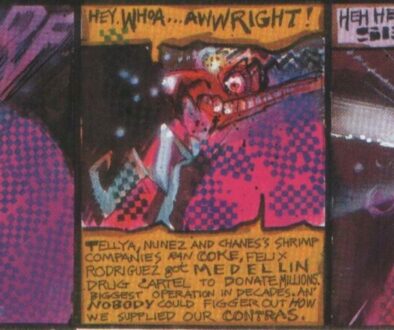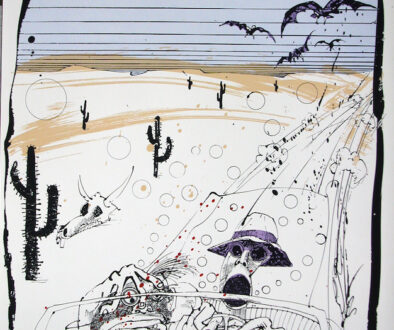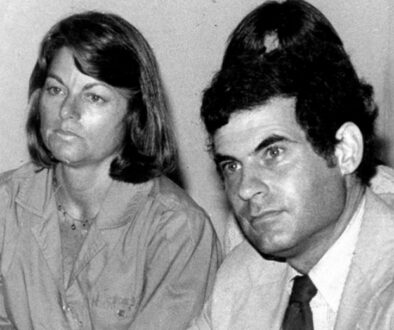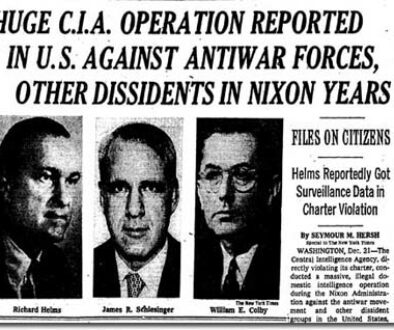 |
| Figure 635: A tall giraffe galloping like a rocking horse. |
This is certainly a harsh assessment, but it is in truth difficult to argue. Consider, for instance, her account of the group’s adventures in the Land of Take-What-You-Want, in which “if you want anything, you can usually get it there for nothing.” At one point, the adventure goes as follows: “‘Do you want a nice fat lion, Jo?’ asked Silky, as a large lion wandered by and licked Silky’s hand. ‘No, thank you,’ said Jo, at once. ’Well, what about a giraffe?’ said Silky. ‘I believe they make fine pets.’ ‘You believe wrong then,’ said Bessie, as a tall giraffe galloped past like a rocking-horse. ‘Nobody in their senses would want to keep a giraffe for a pet.’ ‘Oh, look!’ cried Fanny, as she came to a shop in which stood a great many large and beautiful clocks. ‘Do let’s take a clock back home!’” This is largely par for the course for Blyton.
 |
Figure 636: V reads The Magic Faraway Tree to Evey.
(Written by Alan Moore and Enid Blyton, art by David
Lloyd, from “Violence” in Warrior #9, 1983) |
In the 1943 sequel The Magic Faraway Tree, Blyton creates a land not entirely dissimilar to the Land of Take-What-You-Want, the Land of Do-As-You-Please. In it, Jo drives a train, Fanny gets everyone elephants to ride, and Dick (a new character in this book) goes swimming. Then Moon-Face gets an idea for something to do: “‘Let’s dig an ENORMOUS castle!’ cried Moon-Face. ‘Then we can all sit on the top of it when the sea comes up.’ ‘We can’t,’ said Silky, suddenly looking sad. ‘Why not? Why not?’ cried Jo in surprise. ‘Isn’t this the Land of Do-As-You-Please?’ ’Yes,’ said Silky. ‘But it’s time we went back to the Faraway Tree. This land will soon be on the move-and nice as it is, we don’t want to live here for ever.’ ‘Gracious, no,’ said Jo. ‘Our mother and father couldn’t possibly do without us…’” This portion of the book makes an appearance in the first part of V for Vendetta, with V reading it to Evey as a bedtime story before leaving to kill Delia Surridge. Its significance is straightforward enough – the Land of Do-As-You-Please is clearly a vision of an anarchist society, and is indeed what V comes to call the society he brings about over the course of the story.
But the use of such a ruthlessly establishment piece of culture is significant in its own right, further cementing Moore’s implicit case that the anarchic tradition he’s espousing is an integral part of British culture. By taking the ridiculously contrived and sudden departure from the Land of Do-As-You-Please and juxtaposing it with V murdering someone, Moore highlights the possibility that is fundamentally unspeakable within Blyton’s bland and anodyne tale: that one doesn’t have to leave the Land of Do-As-You-Please, and that anyone in their right mind would want to live there forever. And so the sort of revolutionary freedom that Moore espouses is revealed not as some external force trying to destabilize British society, but as something that’s slumbering deep within Albion’s psyche.
 |
Figure 637: Although both remain masked
at all times, Judge Dredd and V represent
diametrically opposed visions of the law. |
But perhaps more significant is the way in which this viewpoint can be said to have been lurking within British comics in 1982. It is worth noting that although Moore includes it in his 1983 catalogue of inspirations, many of these later interviews downplay what might fairly be called the most obvious inspiration for V for Vendetta, especially given Moore’s existing career at the time he created it, namely Judge Dredd. Moore, after all, had become a frequent contributor to 2000 AD by the time Warrior #1 came out, and was specifically drawn to the satirical aspects of the comic, which Dredd was in many ways the epitome of. And V for Vendetta can easily be read as a straightforward inversion of Judge Dredd. Where Dredd is an eternally-masked figure embodying absolute and unwavering authority who’s presented as the hero of his stories while constantly being undermined and revealed as the fascist monster that he is, V is an eternally-masked figure embodying complete and utter rejection of authority, initially presented as the villain of the piece while tacitly endorsing his position. In many ways, the entire strip is a logical iteration of the British comics industry as it existed when Moore was writing it – a revision of the industry’s most popular character that makes its point directly, instead of through irony-laden satire.
 |
Figure 638: Dez Skinn’s “Freedom’s Road”
editorial from Warrior #1 |
This is particularly unsurprising given the publication it was appearing in. Warrior was, by design, the brasher cousin to the rest of the market. Its first issue opened with an editorial titled “Freedom’s Road,” in which editor Dez Skinn boldly proclaims that “while the large comics publishers seem to be in a period of creative regression, we hope our attempt, our one little magazine in a sea of others, will spark off enough interest to get things moving again.” In a later interview, Skinn explained that, after leaving Marvel, he wanted “to stop doing quantity and start doing quality,” and so “took the team I had built up at House of Hammer, Doctor Who, and Hulk (the comics I’d produced previously) and said to them, ‘Okay, let’s do it again but for ourselves this time.’”
This latter quote indicates the complex sort of waffling Skinn was engaged in. On the one hand, the “for ourselves this time” attitude suggests the sort of soaring iconoclasm whose promise is implicit in the title “Freedom’s Road.” It positions Warrior as a sort of cousin of Near Myths – a magazine that would fuse the intelligence of the underground with the accessibility of the mainstream. It also had a practical aspect: Warrior was, unique in the mainstream British comics industry, a creator-owned publication, which meant that, for instance, Steve Moore and John Bolton owned The Legend of Prester John and Father Shandor, Demon Stalker and would be in a position to profit directly from any success the properties had. In fact, this was part of Warrior’s business plan – Skinn stood to profit from any foreign publication or larger success as well, and every strip was designed with an eye on that market, so explicitly that Moore, when developing a proposed Warrio strip called Nightjar with Brian Talbot, noted that Talbot should plan the art so that it would be easily colorized for foreign markets, noting “I know this sounds like a remote shot, but Dez is very definitely gearing himself up towards finding space in that kind of market.”
 |
Figure 639: Steve Moore and Steve Dillon’s take on Nick Fury was a
precursor both to their Laser Eraser and Pressbutton and their creation
of Absalom Daak, Dalek Killer. (From Hulk Comic #9, 1979) |
But in some ways the really revealing thing is Skinn’s explicit decision to model the contents of Warrior on his previous success with Marvel UK’s Hulk Comic, with several of the strips in Warrior being direct mirrors of those in Hulk Comic, often with the same creators, such as Steve Moore and Steve Dillon’s Laser Eraser and Pressbutton, a clear reworking of the pair’s Nick Fury strip in Hulk Comic, or Steve Parkhouse’s The Spiral Path, which was modeled directly on the Black Knight strip he’d done for Hulk Comic. As Skinn freely admits, “”we were not really trying to create something new.” This points at an important aspect of Skinn’s editing of Warior, which was that he was, in a number of ways, extremely conservative and cautious. He once rowed with Moore over whether to tone down the language in one comic, rhetorically asking Moore “why offend even one reader,” to which Moore strenuously objected, pointing out that “the alternative is to gear your entire product to the most squeamish and prudish member of the audience,” and Moore, while outlining Nightjar to Talbot, noted that “we do have to appeal to people with some pretty base sensibilities. Dez, for one.” This made Skinn an awkward editor for an iconoclastic publication like Warrior.
 |
Figure 640: Night Raven’s
menacing note on his victim.
(Written by Steve Parkhouse,
art by David Lloyd, from Hulk
Comic #1, 1979) |
It also serves to expose, underneath the vast web of influences upon the strip, the actual pragmatic reason why V for Vendetta exists, which is that along with his clones of the Nick Fury and Black Knight strips, Dez Skinn wanted a version of another one of his Hulk Comic strips, a 1930s noir strip by Steve Parkhouse and David Lloyd called Night Raven. The strip was a triumph of the sort of conceptual minimalism that characterizes British comics. Its debut was a three-page story in which the eponymous masked vigilante crashes a meeting of crime bosses and successfully picks them off one by one, grabbing the last one by the head and branding him with his sigil, leaving him catatonic. The strip is bookended by the two trademark phrases of the strip – its opening line of “Night-time in the city…” and the note that Night Raven leaves with his last victim reading simply, “where brooding darkness spreads its evil wings the Night Raven stings!”
 |
Figure 641: Night Raven allowed David Lloyd to play to his
strengths, particularly in its action sequences. (Written by
Steve Parkhouse, art by David Lloyd, from Hulk Comic #3,
1979) |
These two lines constitute, in practice, the entire concept of Night Raven as a strip. The character is not given any sort of origin or explanation. The city is never named. There is no sense of context – subsequent strips simply find new corners of the city in which Night Raven can bust new sorts of crime. All of that is visibly extraneous. The purpose of Night Raven is simply to allow for a three-page slice of action in a pulp noir aesthetic. In this regard, the creators could hardly have been better chosen. Steve Parkhouse is one of the unheralded greats of the British comics industry – one of those whose style is so particularly focused on the structures of British comics that he never broke out elsewhere. Which is to say, he’s a particular master of the ultra-short form. His stories often hang together strangely at best when read as continual narratives, but on an individual chapter level they’re unparalleled, and Night Raven exemplifies this in its discarding of everything that isn’t immediately relevant to creating a compelling action scene. And the noir setting brings out Lloyd’s strengths, allowing him to use large patches of shadowy blackness and giving him lots of action sequences, while also blunting his biggest weakness by not requiring a large variety of facial expressions and by making the slight grotesqueness of his characteristic bulging eyes an appropriate part of the tone.
 |
Figure 642: Paul Neary’s illustration to his Night Raven story
“Killing by Numbers.” (From Marvel Super-Heroes 384, 1982) |
Night Raven ran for fourteen installments in Hulk Comic under Parkhouse and Lloyd, and then for a further six with John Bolton replacing Lloyd on art (due, apparently, to Stan Lee’s distaste for Lloyd’s art) for a Yellow Peril-infused adventure pitting Night Raven against “Yi Yang, leader of the Dragon Tong… radiant as a rose, but with a heart as cold as steel,” at which point it became a casualty of Hulk Comic’s steady transition to being a US reprint comic like the rest of the Marvel UK stable. It was, however, popular enough to merit continuation as a series of text features, first in Savage Action, and then, when that title was merged into it, in Marvel Super-Heroes, where it appeared alongside the Dave Thorpe Captain Britain strips. These features, by Paul Neary and Alan McKenzie (writing under the Marvel UK house pseudonym of Maxwell Stockbridge), were fairly generic stories in the pulp fiction milieu, following straightforwardly from the Hulk Comic strips. (“It was New Year’s Eve,” begins one of Paul Neary’s stories entitled “Killing by Numbers.” “The party-going jet-setters whiled away the hours approaching midnight, as the snow fell softly into the concrete canyons of the city. The drifting flakes blotted the squalor and disrepair of the tenements and alleyways from view, but it could never eradicate the deeper, spiritual decay that festered in the souls of the city’s underworld.”)
 |
Figure 643: One of Paul Neary’s illustrations to Moore’s
Night Raven story “White Hopes, Red Nightmares.” (From
Marvel Super-Heroes #392, 1982) |
Once Warrior emerged with their tremendously successful Night Raven clone, however, Marvel UK was quick to respond, putting Alan Moore in as writer of the text pieces. Moore, as is his wont, commenced revamping the character. In typical fashion, Moore brought back supporting characters from the strip’s history, including crime reporter Scoop Daley from Lloyd’s last arc and the return of Yi Yang, who he established as Night Raven’s iconic villain. In similarly typical fashion, he continued by killing Night Raven off, albeit with a twist, with Yi Yang infecting Night Raven with a toxin that, as Moore describes it in his first story, “corrodes the flesh and eats away at the brain until your whole world is just filled with pain and horror and madness. And then it kills you. Fifty years later.” Moore also hit upon the idea of giving the stories a clear narrator other than Night Raven, thus putting the central character at a slight remove to make him, in Moore’s words “charismatic and unknowable.” This is played to its best effect in Moore’s second story, “White Hopes, Red Nightmares,” which tells of a psychotic man named Howard Bates in 1957 who adopts Night Raven’s identity and starts murdering people he believes to be communists while Night Raven himself is semi-amnesiac and reeling from Yi Yang’s poison, but it’s a common element in all but one of Moore’s five tales (and the only one it doesn’t apply to is a one-parter concerned almost entirely with major plot developments).
Over the course of Moore’s stories, Night Raven suffers from the disease until he finally obtains a cure, at which point he realizes that Yi Yang had only done all of this to give herself an enemy. (“How does an immortal kill herself,” he has Night Raven ponder in the story where he’s finally cured. “She sets about creating a weapon, perhaps unconsciously, responding to that barely audible voice inside her that pleads for extinction. She creates a weapon that might just be able to kill her.”) [continued]














February 12, 2015 @ 5:44 am
I always read V's bedtime story juxtaposition a little differently: the reason you can't stay in the Land of Do-As-You-Please is because you can murder people, which prevents them from doing as they please, thus ruining the premise of the entire Land.
I've read many defenses of how an anarchist society would prevent such actions, but many come off as either horribly naive ("No one would want to murder in our utopia") or creating the same thing that anarchy is in direct opposition to ("We'll create a citizens council to track down and arrest/imprison/kill the murderer!"), in the latter case being essentially running back to mommy and daddy — appealing to or creating the kind of "higher authority" anarchism is usually opposed to.
Of course, these seem to be the exact kinds of questions that V is meant to raise in the reader. His murder of Suttridge may be the most compassionate of all of them, but he still kills her for what she did to him. The mere absence of laws or authority wouldn't completely erase historical hatreds anymore than their enactment completely prevents them. Is it inevitable that "true anarchy" is a temporary condition, that we must always leave the Land of Do-As-You-Please due to scarcity, emotions, accidents?
Moore even says something to this effect in a 2009 interview with Margaret Killjoy: "I believe that all other political states are in fact variations or outgrowths of a basic state of anarchy; after all, when you mention the idea of anarchy to most people they will tell you what a bad idea it is because the biggest gang would just take over. Which is pretty much how I see contemporary society. We live in a badly developed anarchist situation in which the biggest gang has taken over and have declared that it is not an anarchist situation – that it is a capitalist or a communist situation. But I tend to think that anarchy is the most natural form of politics for a human being to actually practice."
No doubt one of the other commentators who is better informed in anarchist philosophy and politics can discuss this point better.
February 12, 2015 @ 5:46 am
Bah, that should read "Surridge", not "Suttridge". Silly lack of an edit button.
February 12, 2015 @ 5:53 am
a psychotic man named Howard Bates in 1957 who adopts Night Raven’s identity and starts murdering people he believes to be communists while Night Raven himself is semi-amnesiac and reeling from Yi Yang’s poison
So there's precedent for what Fabian Nicieza did to Anarky; interesting.
February 12, 2015 @ 8:34 am
I still find that house name of "Maxwell Stockbridge" one of the most hilarious things I've ever seen, more because it's such a bizarrely obscure joke for where it appeared rather than the joke itself.
I have a real fondness for Night Raven in general; although most of the pre-Moore text stories are pretty disposable. And at least one or two cross the line to appalling.
February 12, 2015 @ 4:35 pm
Dredd is the Law. Dredd under will.
Do-As-You-Please shall be the whole of the Law.
February 13, 2015 @ 6:22 am
Never heard of Night Raven before, so thanks for this.
February 13, 2015 @ 4:09 pm
There's a person actually named "Killjoy"? :-/
February 22, 2015 @ 3:31 pm
I really like the Night Raven text stories I've read. I have slowly been able to acquire most of them, either through scans or back issues. I'm only missing two (the ones that appeared in Savage Action #14-15). I'm looking forward to finally reading the whole thing someday!